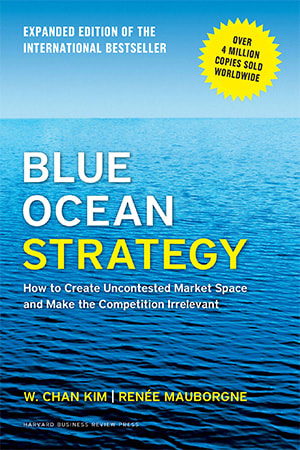 One of my favourite business books of all time is “Blue Ocean Strategy” by Chan Kim and Renée Mauborgne. It was first published in 2005 and has since been published in forty-three languages with over four and a half million copies sold. The basic premise is that most businesses compete in a “Red Ocean”, symbolized by the blood spilled from the fierce, undifferentiated competition in industries with low margins and stagnant or declining demand. The book, and an assortment of online courses and tools that have since been developed by the authors, help business owners and management teams move their business towards a “Blue Ocean”, where they simultaneously lower costs and grow in uncontested market space by creating new demand. Think about how crazy it would have sounded years ago to have a watch that measures your heartbeat or a phone that takes pictures. The shift to a Blue Ocean market requires that business owners think outside the box and is by no means easy to implement. The first step is to initiate a change in mindset and to explore the possibilities. Most businesses have invested heavily in their current market space, by investing in real assets such as equipment, facilities, etc. as well as soft assets such as the workforce, customer relationships, training, IP, marketing, etc. It can be incredibly difficult to pivot a business from the Red Ocean into a new market unless everyone buys in. For relatively successful, established, larger organizations, the organizational mindset change needed can be monumental with embedded agendas, politics, systems, etc. In these cases, it is likely best to implement a Blue Ocean strategy in a specific business unit or product line where the chances of buy-in and success are higher. Theoretically, smaller, more nimble, entrepreneurial-led businesses in the lower-middle market are much more adept at implementing a Blue Ocean strategy. Traditional strategies focus on differentiating yourself by focusing on your core strengths with specific customer segments within your existing market, by either lowering costs or adding unique value. Blue Ocean strategies entail utilizing your core strengths to open up brand new markets by creating new demand. It typically requires the use of the right side of your brain. However, for those of you like me that seem to be deficient in the creativity department, the Blue Ocean book along with the tools it outlines, help you and your team find those viable opportunities to pursue that can begin to move your business, business unit, product line, or product into a new uncontested market space. Once the creative juices are flowing and the mindset has changed, the next step is to pick the best opportunity and begin to formulate the strategy and its implementation roadmap. The book walks the reader through ways to break through traditional competitive market boundaries and reconstruct them to unlock value with current “non-customers”. It also addresses the multitude of traps and obstacles that you are likely to encounter along the way. The critics say that for many businesses moving to a Blue Ocean is nearly impossible. In the end, the book helps owners think about ways to innovate and refocus their efforts on where to invest their time, energy, and resources by moving away from the highly contested Red Ocean and leveraging their core strengths and capabilities. In my humble opinion, most people will garner some ideas that they can use, regardless of what business they are in.
0 Comments
 Many would argue that one of the most important factors impacting the value of a business, is its employees and its management team. A business that relies on its owner for too many critical functions is risky for a new owner and therefore worth a lot less. Incorporating Human Resource (HR) best practices to manage, train, promote, motivate, compensate, retain, recruit and attract the best people can drive enterprise value and its marketability when it comes time to sell. Like many “best practices” it can also provide the business a competitive edge. To meet the needs and expectations of the business, each job throughout the organization should have clearly defined competencies as part of an up-to-date job description. The organization should also have a system to ensure that employees are sufficiently proficient in those competencies. Competencies can be thought of as the observable behaviours, knowledge, ability, and skills of an employee’s performance in a specific function. In other words, it is more about the “how” employees and management perform the tasks associated with their job than the “what.” Defined competencies for a specific job can include both general competencies, such as “customer service” and functional or technical competencies that are job-specific, such as “engineering design.” Defining the specific competencies, along with clear definitions of expected proficiency levels, for each job, can become the backbone of an effective HR management system. Besides the obvious benefit of using for performance evaluation reviews and determining compensation levels, the incorporation of competencies into job descriptions has many other benefits. For example, managers and supervisors can use both job-specific and general competencies to evaluate potential candidates against open positions. With the right systems in place, management can gain a deeper understanding of the organization’s competency gaps which can be incorporated into training or recruitment programs. This becomes critical as a company grows or when there is a change in strategy. Management can use them to re-organize functional responsibilities within a business unit or across the entire company. Employees can use competencies to self-assess their suitability for open positions or to help craft their career path within the business. The bottom line is that when employees and management understand what they need to be good at, how it is measured, and how it contributes to the company’s overall success, they become more engaged. And there is nothing more powerful than an engaged management team and workforce with clear goals and a common purpose when it comes time to sell. |
AuthorWrite something about yourself. No need to be fancy, just an overview. Archives
June 2025
Categories |
